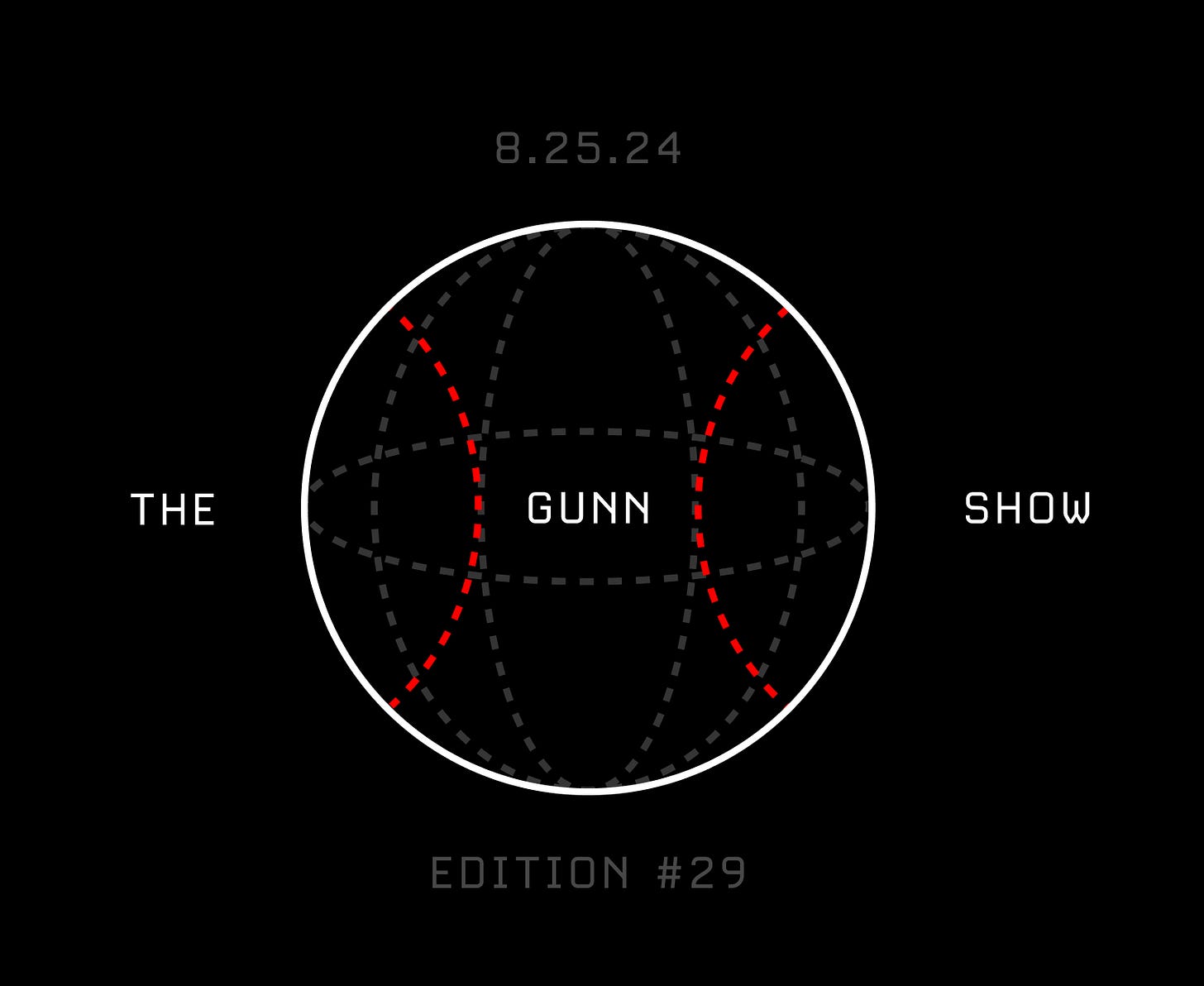The Sports Singularity
Sports are back and on the rise. Why?
Hey Everyone!
Happy Sunday and welcome back to The Gunn Show, hope you all had a fantastic week.
The last couple weeks have meant a large amount of travel on my end, as I’ve been getting out to see each of our Minor League affiliates before the season draws to a close. The latest trip meant a 5 day stretch out in Salt Lake City with our AAA club and it did not disappoint. It was my first time visiting Salt Lake and I can’t think of a better time of the year to go - the 70 degree weather at altitude was just a slight upgrade from the 100+ furnace Dallas has been since the calendar turned to summer. The city itself is was a sight to behold, with beautiful views as a function of it being pressed in between the mountains and Great Salt Lake - here are some of my favorite shots from the week.



For this week’s newsletter, I spent a lot of time thinking about the attention economy of sports - where it has been, where we are now, and where I think we are going. I think there is an interesting story to be told of how sports fit into the broader landscape of the future, namely as a function of how they tap into and engage core human emotions that can only be captured in real life settings.
Hope you enjoy, and as always please share any thoughts my way. Look forward to chatting next week!
- CG
Thinking - The Sports Attention Economy
Let’s start by taking a trip back in time together. The year is 2019 and something strange is happening: sports, one of America’s most beloved institutions, are dying.
Turn on any news or sports channel at this time, and you were likely to find this popular doomsday narrative as the hot topic of discussion. Games were too long, tickets were too expensive, storylines were becoming too politicized, and sports as a product were becoming less compelling. People were starting to spend their time doing other things, looking for better ways to invest their most important asset: their attention.
And truth be told, there was some data to back it up - with virtually no sport immune. From 2016 to 2017, the NFL saw a 10% decline in ratings. The NBA experienced the same from 2018 to 2019. Attendance for one of America’s most revered sports, NCAA football, dropped three straight years from 2016 to 2019. Even our nation’s great past-time, Major League Baseball, was on life support, as 2018 marked the lowest World Series ratings since 2014 and the 2019 season followed-suit by posting the lowest full-season attendance numbers since 2003.
Competitive athletics had had a great run, but in the digital era consumers were in need of something else. At least we were led to believe. Because as it turns out, that narrative was wrong.
As we stand in 2024, sports are back on the rise like the Undertaker emerging from his coffin, with the major sports showing strong rebounds in terms of both attendance and viewership. 2022 marked the highest NFL average attendance since 2016 with Super Bowl LVII between the Chiefs and Eagles drawing 113 million viewers to make it the second most watched Super Bowl in history. MLB has punched back heavily, drawing 70 millions fans to ballparks in 2023 - the highest total since 2017. NCAA football, too, has returned to it’s lofty heights with 2023’s average attendance eclipsing 41,000 per game to represent the highest mark since 2017.
Put simply: sports are back. So what happened?
I’ve been thinking a lot about this question recently, trying to understand the rationale behind the dip and subsequent resurgence in sports interest over the last decade plus.
There are a number of possible explanations, many of which have been much discussed at length in the public domain. But at the top of the list is a rather simple one: sports, and the leagues within which they operate, have evolved because they had to. The argument goes like this: the people charged with oversight of their respective sports saw the problem at hand - that people were wanting to engage with things other than sports - and figured out ways to solve it.
They knew attention spans were becoming an issue and that they needed to make their products shorter, and created pace of play rule changes like running play clocks in college football and the pitch timer in MLB.
They saw how increased digital content was creating challenges in captivating attention and thus strove to make their sports more compelling, implementing ideas such as kickoff changes in the NFL and the rise of live sports betting.
They watched as young people were favoring social media as their entertainment of choice and sought to make their sports more engaging, custom tailoring content to platforms like Twitter, TikTok, and Instagram to enhance their reach and connect with future generations.
Add on top of these things like scheduling changes, playoff expansions, E-sport partnerships and more and you can easily tell the story that it wasn’t any one of these things but all of them in conjunction that have brought people back to sports.
But the more I’ve thought about the sports engagement problem, the more I’ve come to think that all of these changes are small potatoes in the grand scheme of things; the more I’ve come to believe that that V shaped curve might have happened anyways, regardless of whether or not these changes were made.
Let me explain why.
From my perspective, the sports engagement/viewership discussion pinned the issue on the wrong boogeyman from the start - namely, it operated around the assumption that there were things inherently flawed about sports themselves, and that these flaws were what were leading to the subsequent decrease in popularity. Fix the flaws - fix sports - and the people would come back, the logic said.
But this framing of the problem never made much sense to me because it relies on two assumptions that I think are highly unlikely. In order to make the argument around the end of 2019 that sports were broken and thus dying, you would’ve needed one of two things to be true: either (a) sports had always been broken or (b) sports had broken overnight.
In regards to the sports have always been broken argument, I don’t think there is much solid ground for it to stand on. Humans are a competitive species by nature, and sports have thus served as a fertile ground for our species to satisfy one of our most core needs for centuries. They have been engrained into the fabric of human society for thousands of years and we can go all the way back to 3000 BCE to find the origins of competitive athletics, when the Ancient Mesopotamian’s settled arguments with wrestling and boxing matches and the Egyptians partook in archery and javelin throwing competitions. I find it hard to believe that something that has existed for at minumum 5000 years has risen to be such an integral piece of society while possessing fatal flaws all that time.
The second argument - that something changed and broke sports - is perhaps more plausible in theory, but I still believe to be equally unlikely in reality. You could make reasonable points about how sports had set itself up for failure - you could say that the institutionalization of athletics at the professional and collegiate levels had caused them to become too bloated, that they had lost their soul, that what made them successful for so many years had fallen to the wayside amidst all of the struggle for money and power. And yet while I find myself agreeing with those arguments to some extent, they still wouldn’t explain why something that was still amassing incredible popularity into 2015 started to see a sharp decline soon thereafter. If there was a single, demarcated point in time that causing Americans across the country to stop watching, I’m still looking for it. There must be something else at play.
What that is didn’t click for me until this past week, when I came across two pieces of content in quick succession that I think provide an explanation when threaded together: namely, that the V shaped curve of attention in sports in not a sport specific problem alone. It exists at the full societal level, and sports as a subset have been caught up as a result. It is a story of the digitization of our world, and how that change has shaped what we pay attention to - and why.
The first piece that made me think about the problem differently came from the economics side, in a thread from Raoul Pal, the Founder of Global Macro Investor. The tl;dr of the tweet is that Raoul believes that the evolution of technologies like AI, robotics, and renewable energy are likely to cause a societal disruption point beyond which our traditional economic frameworks will no longer be applicable - the point he deems the Economic Singularity. At it’s core, his argument is about technology and the digitization of the world making what used to be true in the past no longer true in the future. And while he makes a number of recommendations in terms of what that means for markets and businesses, one broader one stood out in particular: that the increasing rise in non-human centric technologies (AI specifically) will place a resulting premium on the value of human connection, in turn making it more valuable than ever. Raoul is right, and another piece helped me see why.
The second article I came across was written by Jack Raines of Sherwood news, titled Analog is Cool Again. In the piece, Jack builds a compelling argument that after nearly 30 years of digitalization, some parts of the world are starting to revert back to their prior analog, ‘non-digitalized’ states. As screens and the internet have become more ubiquitous, many people are starting to ask an important question - namely, what do we need screens for, and where would we be better off without them. From Jack:
We kept digitizing more, and more, and more, because for the generation that built the internet, digital was always better.
But for the younger millennials and zoomers (like me) who grew up in a world where fully digital was the norm, the question is no longer what can we put behind a screen, but what should we? Which screens were mistakes? What should be reverted? Which “progress” actually set us back?
My takeaway from Jack’s piece was the following: some things are better lived through screens, and some things are better lived through life. But as screens became more ubiquitous we started to lose sight of this dichotomy, trying to fit the things that are meant to be lived in person to the screen rather than thinking about what makes the real thing special in the first place.
Which brings us back to sports.
From my perspective, the story of sport over the last 30 years perfectly mirrors this trend: as the world has become more digital, we have tried to make sport fit to all the implications of the screen rather than recognizing that it’s true superpower is that it never needed the screen in the first place.
To borrow from Jack’s phrasing, sport is one of life’s greatest analog phenomenons. For as long as it has existed, sport has revolved around real people in real places, the great desire for human competition played out in real life. There is no experience like the live, in-person environment of elite sport, whether you are a player on the field or a fan in the stands. To be in a stadium of tens of thousands of people is a sensation that cannot be accurately represented in any other form - even as good as the TV viewing experiences now are. It is an opportunity to feel the environment, to live the moment in time such that you become one with the atmosphere, the energy, the passion. That is always what has made sport so - and nothing about the world and technology will ever change that.
If Jack is right that people are going to increasingly come back to the analog - which I believe he is - then people will keep coming back to sport. Regardless of rule changes, content formatting, and any other decisions made be people leading sport institutions - my bet is that sports will continue to stay on the rise. Games will continue to be played, stadiums will continue to be filled, televisions will continue to be turned on - if only for the reason that sport gives people a human experience that cannot be captured better elsewhere, in any other form.
And so while Raoul predicts an economic ‘singularity’ in which all of our rules for the world should change, my prediction for sport is exactly the opposite. Instead of placing our bets on what will change, for sport we need to place them on what shouldn’t - namely, that they should serve as one of the last - and best - bastions for human experience. They should continue to pull at the same emotional strings they have for millennia - the desire for competition, for connection, for excitement, for passion. Every decision made for the future of sport should keep this in mind - let us tweak them as we must, but at the same time be sure we are not losing its soul in the process.
Because the more we live our lives with a screen, the more we will come to yearn for the things that represent the real.
And there are few things more real in this world than sport.
Reading
Raoul Pal on the ‘Economic Singularity’ (~4 min)
One of the sources of inspiration for the above post, this was a great forward looking framework to help inform how we think about the impact technology is having on our world.
Jack Raines on Why Analog is Cool Again (~ 5 min)
If you read one thing from this section this week, let it be this one. I outlined some of Jack’s perspective above, but think his full take on how the world is reverting back to physical experiences is important.
Naval on Thinking and Lifting (~1 min)
A great tweet from Naval on two important targets: a strong body and a strong mind: “Quick to learn and hard to kill”.
Peter Attia In-Depth Breakdown of Z2 Training (~27 min)
A full guide to how to think about Z2 training from one of the best out there.






